#stage door 1937
Text





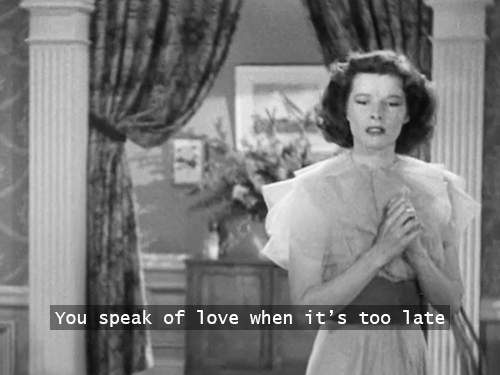
Terry Randall / Kay Hamilton
Stage Door (1937)
#i'm throwing my hat in the kay/terry ring#i know everyone ships ginger rogers & katharine hepburn in this movie but please consider 🥺️🥺️🥺️#stage door 1937#andrea leeds#katharine hepburn#classic movies#vintage movies#my edits
51 notes
·
View notes
Photo


What if you’re a failure? What then?
9 notes
·
View notes
Text

sarah bernhardt’s missing leg
3 notes
·
View notes
Text


The Film Daily, October 5, 1937.
#stage door 1937#1930s#the film daily#katharine hepburn#ginger rogers#gail patrick#lucille ball#andrea leeds#old hollywood#old movies#old magazines#old movie stars#classic hollywood#30s movies#1930s movies#1930s cinema#30s film#pink#old hollywood movies
4 notes
·
View notes
Text

Ginger Rogers in Stage Door, 1937.
13 notes
·
View notes
Text
I don't know where else I could say this, where someone might understand and care but like, I just have to say it!
Ginger is just sooooooooooo beautiful, I just can't with her!!! 😯😃🤩🥰😍💖
I watched this little clip from "Stage Door" (1937) again yesterday and I can't believe just how beautiful she is, look at this incredible body of hers and her wonderful face! 💗
youtube
She's unbelievably beautiful and so cute and feisty, I'm in awe. 😍
How Fred could work with her so closely and not lose his calm is beyond me. How he could be with her so physically close and not want to touch her, I don't quite understand, he's a man after all! I would've guessed that a guy like him would become incredibly possessive and protective of a woman like her. But then again, we don't know all that much about their private relationship. Maybe he did.
I mean, just look at her, I'm so in awe of her beauty all around. She was so thin and so elegant and so pure and clever. What a lady!

#ginger rogers#fred astaire#what I'm saying is we need more decent (!) fanfiction!!!#Virginia mcmath#Frederick austerlitz#Old movies#Womanhood#Beauty#Stage door#1937#old hollywood#fred astaire and ginger rogers#Dancing#Youtube
5 notes
·
View notes
Photo

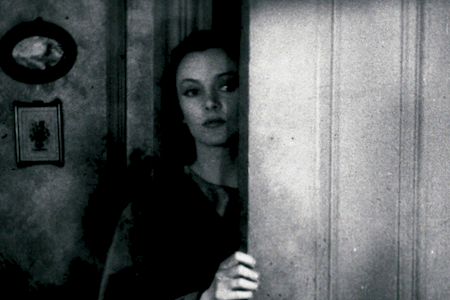
Isn't there enough heartache in the theater without our hating each other? ANDREA LEEDS (Kay Hamilton) in STAGE DOOR (1937) | dir. Gregory La Cava
#1930's cinema#`1930's#1937#stage door#andrea leeds#gregory la cava#oldhollywood#filmblr#classicfilmsource#filmedit#dramaedit#dramagif
4 notes
·
View notes
Text

Lucille Ball, Ginger Rogers, and Ann Miller in Stage Door (1937)
180 notes
·
View notes
Text
Hadestown Matinee notes 15/6/24
Someone wolf whistled Hermes at the start and Melanie acknowledged it
When Eurydice showed some shoulder in wedding song, Orpheus’s ‘yes’ cracked
If I didn’t know All I’ve ever known was meant to represent a love making scene before I sure would now, in the most respectful way possible Donal and Grace’s Orpheus and Eurydice is the most passionate I’ve scene 😭 like god damn did they make out afterwards, grabbing each others hair and everything
Eurydice holding Orpheus instead of him holding her in Way down
When Eurydice said “kinda makes you wonder how it feels” and Hades acknowledged it, she looked super embarrassed and turned towards the crowd
Eurydice running the carnation down Orpheus’s chest all the way to his belly button I was like girl-
Zack’s hades remains the cuntiest
Eurydice crying as she fell into the underworld when Orpheus turned
Donal writes random crap in his notebook, he told us at stage door even he doesn’t understand it.
Not a note from the show itself but a lady next to me gasped so loud and physically drew back when Orpheus turned around
Tiago and Winny twerking on each other in Livin it up on top
Eurydice literally hyperventilating during why we build the wall
Zackary told us that the newspaper he reads is a New Orleans article from 1937, he also said it’s the same paper every night so he’s kind of bored of reading the same sections over and over.
I thought last time I saw Gloria she was going through something bc she was crying so much, but nope, she’s just an amazing actress who puts an insane amount of emotion and passion into her role

#hadestown#hadestown UK#west end#lyric theatre#grace hodgett young#donal finn#melanie la barrie#gloria onitiri#Zackary James#hadestown west end#Orpheus#Eurydice#Persephone#hades#Hermes#the fates
55 notes
·
View notes
Text

Director Gregory La Cava with Eve Arden on set of STAGE DOOR (1937)
57 notes
·
View notes
Text
Sunday Steve - Day 13.5: What Did a Tenement Look Like?
As a follow up to my tenement building post, I've done my best to find a collection of photos to show what apartments Steve lived in could have looked like. As I mentioned in my earlier Sunday Steve post, a lot of tenement pictures were taken specifically because of the poor conditions, so I tried to find pictures that would show a side of tenements we might not usually see.

Tenement playground, circa 1900-1937 (Link)
Contemporary photos

Interior stairwell, 1937. (Link)
Look at the wallpaper! Also I can just imagine children playing in that nook there, using it like a fort or something.

Interior between 1900 and 1910. (Link)
Look at all the pictures on the walls, the patterned and no doubt colourful table cloth and the decorative elements of the stove! This apartment looks like it has a gas stove and lights.
(part of me does wonder if this photo was staged to some extent, perhaps to advertise the new laws going in (?), but that's only a theory.)
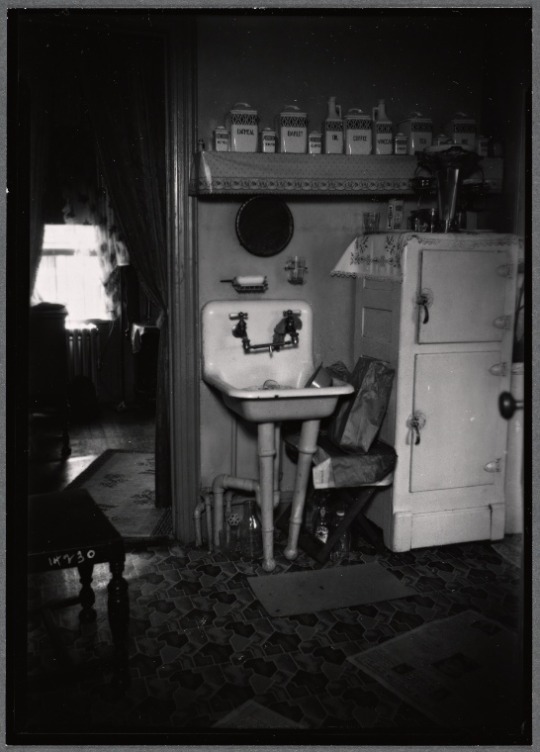
Kitchen interior with sink and icebox, 1935. (Link)
You can see the draped curtains, the mirror above the sink and the cloth on top of the fridge. The shelf with all the jars has been recovered with a decorative trim and the floor is patterned linoleum.

Family at kitchen table in a dumb-bell tenement, circa 1935. Note the angled kitchen window by the stove looking into an air shaft. (Link)
(The Barnes family anyone?) Again, patterned, clean floors, a gas stove, what may be a folded up bed in the left-hand upper corner. Five toothbrushes above the sink, a mirror above the shelf, the trim on the shelf itself. I think the dark thing next to the boxes in the lower right-hand corner might be a toy pram.
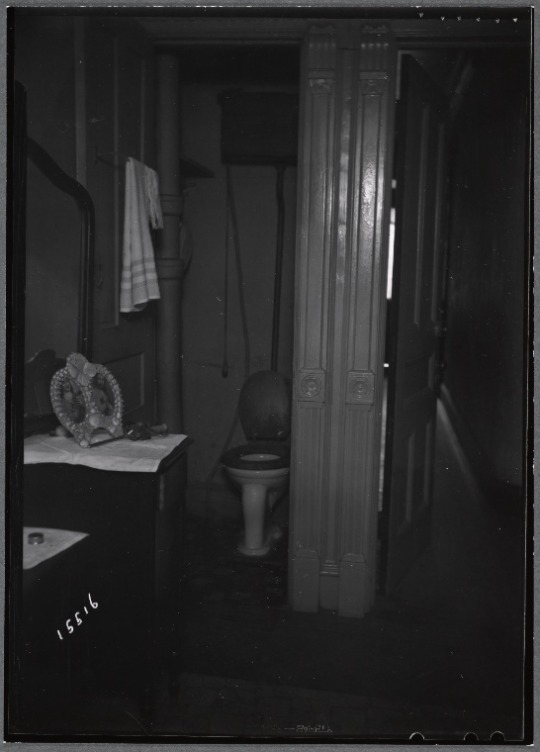
Interior view of dressing table and toilet, 1936. (Link)
Typical small toilet, probably built after the New Law required them. Note the pretty framed photo of religious figures on top of the dressing table, what I think is an electric curling iron next to it, and the sculpting details of the wall pillar.
Reconstruction
But black and white photos don't give us a full idea of what things would be like. Luckily, there is Tenement Museum in Manhattan that has 1910 and 1930 Old Law restored tenement apartments.


Outside of museum and stairs leading up. (Link)
This tenement is 5 floors, which is standard for Old Law. New Law tenements were often higher. The tenement, like many tenements, had a store front on the street level.
If you look carefully you can see the tin-plated ceilings. Note how you can see a painting on the wall across from the stairs. In the tour they discuss how these were people's homes and they decorated them and were proud of them too.




Images of a 1910 style apartment. (Link) (Link)
These tenements are 3 rooms, bedroom, kitchen and parlour. Note the bed in the kitchen where Steve could've slept. This could also be a place for a crib for a baby. These apartments have shared toilets in the halls that were for two families.
Also look at the green and red walls! So much colour! And the pictures hung on the walls! There's a rug on the floor, doilies and a cushion on the couch, a patterned curtain behind the door... I wanted to highlight the homeyness.
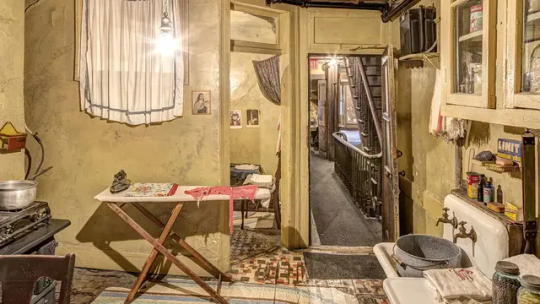

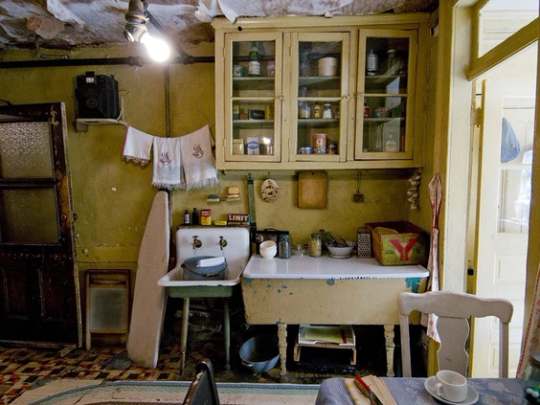
Kitchen of 1930s style apartment. (Link) (Link)
With these photos you can see the three rooms of this tenement. A small bedroom by the front door, a kitchen and a living room past it. The apartments for this building were electrified in 1924, so they have lights, and a radio and an electric fan in the living room.
The apartment had coin operated gas, which could be the black box on the wall by the front door. The gas also connects to a water heater for this apartment which can't really be seen, but it is connected to the stove.
The built in shelves by the table was custom built by the father of the family living here. Residents often painted or wallpapered their space when moving in to make it their own. According to the Tenement Museum, linoleum flooring was really common, and you can see how this apartment has linoleum designed to look like a rug.


Living room and bedroom of the same 1930 apartment. (Link) (Link)
The living room isn't very staged, I'm not sure why since I haven't taken the tour. There is a disassembled bed frame against the left wall, so it's possible a bed is usually set up in this room for the parents. Also the former resident of the apartment said it was sparsely furnished, so they may be trying to recreate that.
The ice box for this family is kept on the fire escape, which is not shown.
In the window of the living room you can see green plants. These are morning glories the father planted in re-purposed cheese boxes. According to the former resident, they got the cheese through welfare aid, and cheese always seemed to be in surplus from that program. The apartment has electricity and there is an electric fan on on the dresser with the mirror.
The second photo shows the bedroom, which is that angled room next to the front door in the kitchen. The red cloth covered thing in is a bed that was shared by two siblings and folded up and covered every day.
Look at all the colour! The patterned linoleum floors! The climbing flowers in the living room window! The radio in the nook by the kitchen table! These places were not dreary and brown just because they were old or cheap.
Recollections from the previous resident:
Rosaria [her mother] decorated the apartment by draping fabrics everywhere: lacy curtains at the windows, coverlets in the beds, skirts across the shelving that Adolfo [her father] built into the walls. The family kept birds as pets. They cultivated flowers; morning glories twined at the window. The radio played, day and night, as they laughed with Amos and Andy, hummed along with Fred Waring and his Pennsylvanians, and followed the puzzling, upper-middle-class lives of One Man's Family. (Link)
Also, when the previous resident came back to see the tenement museum of her childhood apartment, she noted that the place was messier than her mother ever kept it, so they fixed that. Tenements could be very clean and well kept, especially since cleanliness and health were something people judged.
I really wanted to show that while small and cheap, Steve’s apartments would have still been full of life and colour.

Tenement Museum hall toilet, circa 1904-1935 (Link)
I don't know what time period the museum has this toilet as, but you can see how small it was, and also that it has bright yellow walls!
This toilet has a leaflet of papers on the back wall, probably for toilet paper. As my toilet paper post discussed, toilet paper became more common with indoor plumbing due to clogged pipes and such, so I imagine this is early 1900s. I'm fairly certain Steve would be used to using toilet paper!
What's with all the indoor windows?
A lot of Old Law tenements have windows leading from one room to another. These are for airflow and light. They are also a sneaky way the landlords tried to get around the law that every room had to have a window. The New Law later required the windows to actually have access outside.
These windows are also known as tuberculosis windows. While they may have been a cop-out by landlords, they were still intended to improve airflow and light in narrow tenements which would otherwise have only one outward facing window.
I hope this overview gave you a broader understanding of what tenements could look like and some appreciation of the ways people brightened up their homes.
Many more tenement pictures found here:
This link has a lot more interior shots, but also some with homicide victims (!), so approach at your own risk.
This link has more images of the Tenement Museum, showing other bedrooms from different eras and different tenement rooms. While some are styled as late 1890s era apartments, they still reflect what rooms and life would and could have looked like.
Sunday Steve Masterpost
#sunday steve#steve rogers#tenement#tenements#tenement buildings#interiors#reconstructions#photos#photographs#early 20th century#20th century#american history#history#1900s#black and white#black and white photo#colour photography#meta#steve rogers meta
54 notes
·
View notes
Photo


STAGE DOOR, 1937
277 notes
·
View notes
Text
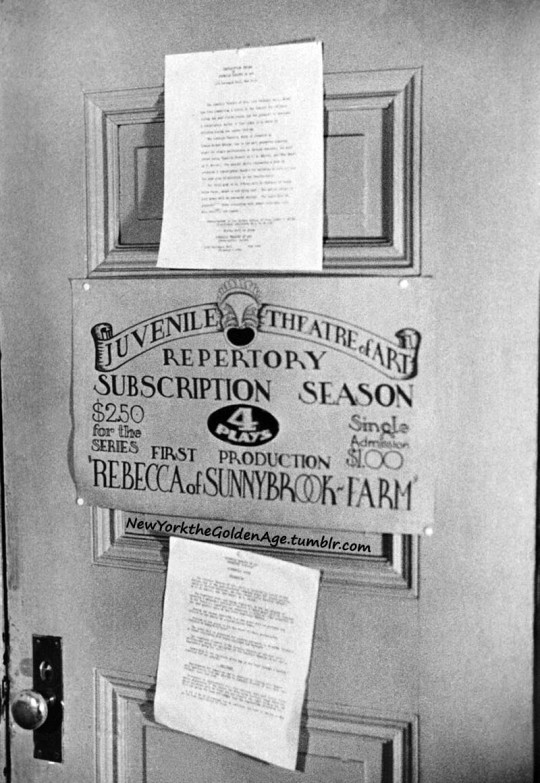
Child actors, employed with increasing frequency onstage and in radio, had a drama school of their own in the 1930s. The Juvenile Theatre of Art trained them and gave them an opportunity to act in repertory company at Carnegie Hall. It produced four plays in the 1937-38 season for paid audiences. This was the stage door on January 21, 1938.
Photo: Associated Press
#vintage New York#1930s#child actors#professional children#drama school#Jan. 21#21 Jan.#acting school#children's acting school#Juvenile Theatre of Art#Carnegie Hall#theater
22 notes
·
View notes
Text
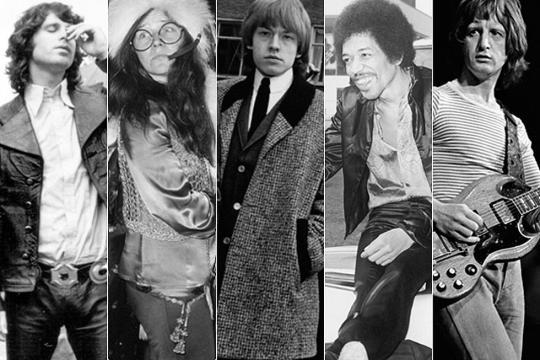
THE 27 CLUB
The untimely deaths of famous musicians at age 27 may be coincidence, but it is tragic coincidence. The mythology of the 27 Club gained prominence with the death of Kurt Cobain in 1994 since he died at the same age as iconic rock musicians, including Jimi Hendrix, Janis Joplin and Jim Morrison, when they died in the 1970s. The premature death of Amy Winehouse at age 27 in 2011, again renewed interest in the age's apparent curse. This is a list of some of the artists and musicians who died at the far too young age of 27.
Robert Johnson (1911-1938) Born 100 years ago in rural Mississippi, the blues singer and guitarist Robert Johnson garnered little attention during his lifetime but was rediscovered in the 1960s, influencing numerous rock and roll pioneers. According to legend, Johnson sold his soul to the devil in exchange for his mighty talent, which he demonstrated on street corners throughout the Mississippi Delta and in the 29 songs he recorded between 1936 and 1937. Famously partial to women and whiskey, Johnson was allegedly poisoned by a lover’s jealous boyfriend or husband.
Brian Jones (1942-1969) A founding member of the Rolling Stones along with Mick Jagger and Keith Richards, Brian Jones developed a severe substance abuse problem that by the mid-1960s had taken a toll on his health, landed him in jail and alienated him from his bandmates. He was forced out of the group in June 1969. The following month, Jones was found dead at the bottom of his swimming pool; police reported that he had drowned while under the influence of alcohol and drugs. Recently, new evidence has suggested that foul play may have had a hand in his death at age 27.
Alan “Blind Owl” Wilson (1943-1970) Known as Blind Owl because of his poor vision, Alan Wilson (first on left) headed up the American blues band Canned Heat, which performed at Woodstock in 1969. A songwriter, guitarist and harmonica player, he famously re-taught the aging blues legend Son House, who had been living in obscurity for decades, how to play his own songs. Wilson, who struggled with mental illness and had previously attempted suicide, succumbed to a drug overdose in September 1970, becoming the first of three acclaimed musicians to die at age 27 that year.
Jimi Hendrix (1942-1970) Remembered as one of the greatest electric guitarists in history, Jimi Hendrix revolutionized rock and roll as both an artist and a producer during his brief four-year career. He died in London in September 1970, asphyxiating on his own vomit while sleeping. His girlfriend claimed that Hendrix, a heavy drug user who was particularly fond of LSD, had washed down a handful of sleeping pills with red wine before going to bed.
Janis Joplin (1943-1970) Born in Texas, Janis Joplin won over the San Francisco music scene with her bluesy vocals and powerful stage presence, first as the lead singer of Big Brother and the Holding Company and later as a solo artist. Despite multiple attempts to get clean, she became increasingly addicted to heroin and alcohol as her career skyrocketed. She died of a heroin overdose in October 1970, less than three weeks after the death of fellow rock icon Jimi Hendrix.
Jim Morrison (1943-1971) A poet and avid reader of philosophy, Jim Morrison rose to prominence as the lead singer and lyricist of The Doors, a band he founded with a friend in 1965. By 1969, his drinking had become a problem, making him late for performances and fueling raucous onstage behavior. In July 1971, Morrison died of a heart attack apparently caused by a heroin overdose while living in Paris. It is thought that he mistook the drug for cocaine and snorted a fatal amount.
Ron “Pigpen” McKernan (1945-1973) A founding member of the Grateful Dead, Ron McKernan, who went by the nickname Pigpen, did not share his bandmates’ predilection for LSD and other psychedelic drugs. However, his heavy drinking caused him to develop cirrhosis in 1970, and by 1972 his health had become so fragile he could no longer tour. He died of an internal hemorrhage in March 1973.
Kurt Cobain (1967-1994) An icon of the Seattle grunge scene, Kurt Cobain formed Nirvana with a friend in 1985; the band achieved mainstream success in the early 1990s. Under a glaring public spotlight, Cobain struggled with mental illness, chronic health problems and heroin addiction. He committed suicide in April 1994, leaving behind his wife, the musician Courtney Love, and their baby daughter.
Amy Winehouse (1983-2011) An English singer-songwriter whose powerful voice and unique style won her numerous awards and honors, Amy Winehouse battled drug and alcohol addiction for years. Her substance abuse problems were frequent tabloid fodder and inspired some of her songs, most notably the hit “Rehab.” On July 23, 2011, Winehouse was found dead in her London apartment, becoming the latest musician to have their career cut tragically short at age 27.
#THE 27 CLUB#supernatural#ghost and hauntings#paranormal#ghost and spirits#haunted locations#haunted salem#myhauntedsalem#paranormal phenomena
8 notes
·
View notes
Photo

Katharine Hepburn and Ginger Rogers in Stage Door, 1937
107 notes
·
View notes
Text

Stage Door, 1937
15 notes
·
View notes